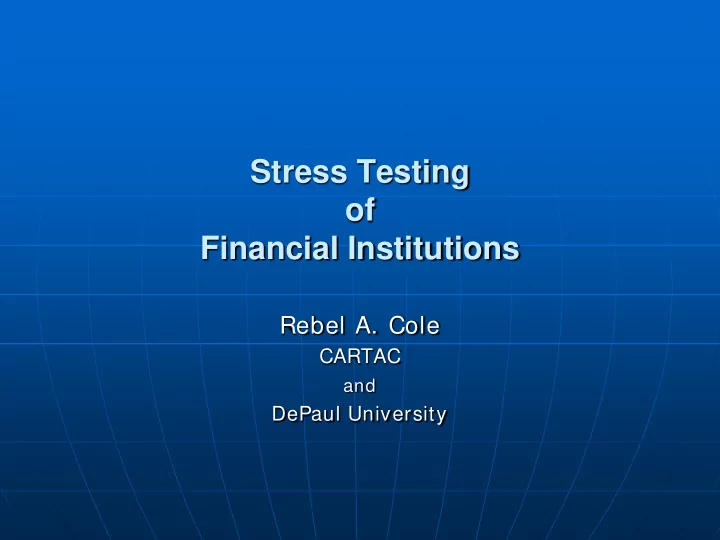

Stress Testing of Financial Institutions Rebel A. Cole CARTAC and DePaul University
Stress Tests Complement to statistical risk- management models, such as Value-at- Risk (VaR), that are based upon the normal distribution. VaR: the expected one-day loss that occurs 1 out of 100 times (99% confidence). This would occur 2.5 times per year.
The Normal Distribution Probability 68% 95% > 99% + 3 – 2 – 1 0 + 1 + 2 – 3 – 27.6% – 7.3% 13.0% 33.3% 53.6% 73.9% – 47.9% Mean = 13.0% Std. Dev. = 20.3%
Problems with Value-at-Risk Most applications of VaR are based upon historical values and the normal distribution. • Normal may not be appropriate • The recent historical experience may not be appropriate • Distributions are assumed stable over time. There is a wide confidence interval around an estimated tail probability. Data intensive: requires a lot of historical data, so it doesn’t work for credit risk.
Stress Tests as Complements to VaR Focus of Stress Tests is on tail probabilities—the “Tails” of the Normal distribution, especially the “left tail.” Highly unlikely, but possible, adverse events and outcomes. It only takes one “outlier” to wipe out a firm’s capital completely. No second chances (unless you are Citibank).
Stress Tests Initially used primarily for "market risks": • Interest-Rate Risk, • Foreign-Exchange Risk, • Equities Risk and • Commodities Risk. More recently, stress testing has expanded to cover: • Credit Risk and • Liquidity Risk.
Stress Tests: Sensitivity vs. Scenario Sensitivity Test: What is the impact of a large movement in a financial variable (such as the interest rate or foreign- exchange rate) on the value of a firm’s portfolio. Reason for movement is not specified. Lacks historical and economic content.
Stress Tests: Sensitivity vs. Scenario Scenario Tests: What is the impact on the value of a firm’s portfolio from simultaneous movements in several financial variables, driven by some event, historical or hypothetical. The tie to a historical/ hypothetical event provides historical and economic content
Stress Tests: Scenarios Example: The “Black Monday” Scenario (Oct. 1987) ( Dow-Jones Industrial average fell by 25% ) Assumption: Equities fall by 25% in one day. • a downward spike in the interest rates likely will follow • interest-rate risk rises • FX risk rises • credit risk rises as equity losses hit investors
Stress Tests: Scenarios 2001 BIS Survey of Stress-Testing Practices at 38 Large Financial Institutions • Very few ran such scenarios with multiple simultaneous shocks. • Outcome of recent crisis is therefore not very surprising. • VaR and the relative calm of the past few years had lulled risk managers into a sense of complacency.
Maturity Gap vs. Repricing Gap Often confused. Maturity gap is important for analysis of liquidity risk: when do assets and liabilities mature? Repricing gap is important for interest- rate risk: when do assets and liabilities reprice?
Interest-Rate Risk: Repricing Gap vs. Duration Gap How will a firm’s capital ratio change in response to a change in interest rates? Repricing gap analysis will provide information about mismatches. Duration gap analysis will provide an actual number.
Liquidity Risk Three basic analysis tools: • Ratio Analysis • Liquidity Gap Maturity Ladder • Cash-Flow Forecasts
Foreign-Exchange Risk Gap analysis of foreign-denominated assets and liabilities. Apply percentage shock to this gap to estimate changes in capital.
Credit Risk Earliest analysis was to simply assume a percentage shock to NPLs without tying to any cause. More recently, estimate relation between NPLs and macro-economic variables. For example, if GDP falls by 1% , then by how much do NPLs typically rise? Problems: is the historical relationship stable over time?
Conclusions Stress Tests are a valuable complement to other risk-management tools. Enable an analyst to explore “what if” we encounter “tail-probability” events, such as the 1987, 1998 or 2008 financial crises.
Recommend
More recommend